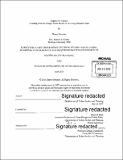Engines of culture : learning from the unique public realm of the long distance train
Author(s)
Sherman, Danya
DownloadFull printable version (24.76Mb)
Alternative title
Learning from the unique public realm of the long distance train
Other Contributors
Massachusetts Institute of Technology. Department of Urban Studies and Planning.
Advisor
Brent D. Ryan.
Terms of use
Metadata
Show full item recordAbstract
The Long Distance American Train is a unique, meaningful, and somewhat mysterious site. These ephemeral, mobile societies exhibit remarkable qualities, including intensive interactions with strangers, conviviality amongst diverse groups, imagination and reflection, and immersion in the American landscape. I conducted participant observation research while riding seven long distance (over 700 mile) trains in December 2014- January 2015 to discover how, why and for whom long distance train travel is unique and meaningful, and whether there were lessons that could be learned regarding how to design and manage the train and non-train public spaces. In addition to my ethnographic research, I analyzed the changing symbolism of the train. My research indicates that the long distance train exhibits qualities similar to Foucault's concepts of heterotopia, and that though it is in many ways private and limited, it also deserves consideration a unique, national public space. The train is also an avatar of modernity, and was crucial in enacting and making possible the American social and spatial landscape inherited from the late 19th century. It is thus an important place to reflect on these conditions and imagine a new path. I suggest that train is able to provide these unique experiences because it exhibits eight spatio- temporal qualities: Functionality, Accessibility, Visual Connection to Landscape, Human-Scale Design, Grounded Placelessness, (De)Regulation, Duration, and Autonomy. Amtrak can build upon its unique platform by improving the train through more fully realizing these conditions. Abstracted, these principles can also be applied to other, non-train public spaces. In comparing the partially successful public realm of the train to status quo of public space design in the United States, I unearth several additional principles that demand rethinking. Finally, I suggest that Amtrak and the U.S. Government can better take advantage of this underutilized platform by enacting a series of changes to great benefit of many passengers.
Description
Thesis: M.C.P., Massachusetts Institute of Technology, Department of Urban Studies and Planning, 2015. Cataloged from PDF version of thesis. Includes bibliographical references (pages 133-136).
Date issued
2015Department
Massachusetts Institute of Technology. Department of Urban Studies and PlanningPublisher
Massachusetts Institute of Technology
Keywords
Urban Studies and Planning.